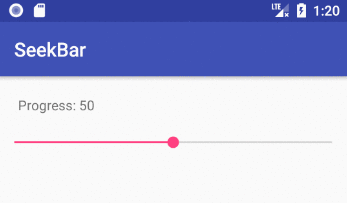Implementing a slider (SeekBar) in Android
I want to implement a slider, which is basically two lines, one vertical and one horizontal, crossing where the screen is touched. I have managed to make one but I have to issues:
- The slider is not very smooth, there is a slight delay when I'm moving the finger
- If I place two sliders it is not multitouch, and I'd like to use both of them simultaneously
Here is the code:
public class Slider extends View {
private Controller controller = new Controller();
private boolean initialisedSlider;
private int sliderWidth, sliderHeight;
private Point pointStart;
private Paint white;
private int mode;
final static int VERTICAL = 0, HORIZONTAL = 1, BOTH = 2;
public Slider(Context context) {
super(context);
setFocusable(true);
// TODO Auto-generated constructor stub
}
public Slider(Context context, AttributeSet attrs) {
super(context, attrs);
setFocusable(true);
pointStart = new Point();
initialisedSlider = false;
mode = Slider.BOTH;
}
@Override
protected void onDraw(Canvas canvas) {
if(!initialisedSlider) {
initialisedSlider = true;
sliderWidth = getMeasuredWidth();
sliderHeight = getMeasuredHeight();
pointStart.x = (int)(sliderWidth/2.0);
pointStart.y = (int)(sliderHeight/2.0);
controller = new Controller(pointStart, 3);
white = new Paint();
white.setColor(0xFFFFFFFF);
}
canvas.drawLine(controller.getCoordX(),0,
controller.getCoordX(),sliderHeight,
white);
canvas.drawLine(0, controller.getCoordY(),
sliderWidth, controller.getCoordY(),
white);
}
public boolean onTouchEvent(MotionEvent event) {
int eventaction = event.getAction();
int X = (int)event.getX();
int Y = (int)event.getY();
switch (eventaction) {
case MotionEvent.ACTION_DOWN:
if(isInBounds(X,Y)) {
updateController(X, Y);
}
break;
case MotionEvent.ACTION_MOVE:
if(isInBounds(X,Y)) {
updateController(X, Y);
}
break;
case MotionEvent.ACTION_UP:
if(isInBounds(X,Y)) {
updateController(X, Y);
}
break;
}
invalidate();
return true;
}
private boolean isInBounds(int x, int y) {
return ((x<=(sliderWidth)) && (x>=(0))
&& (y<=(sliderHeight)) && (y>=(0)));
}
private void updateController(int x, int y) {
switch(mode) {
case Slider.HORIZONTAL:
controller.setCoordX(x);
break;
case Slider.VERTICAL:
controller.setCoordY(y);
break;
case Slider.BOTH:
controller.setCoordX(x);
controller.setCoordY(y);
break;
}
}
private class Controller {
private int coordX, coordY;
Controller() {
}
Controller(Point point, int width) {
setCoordX(point.x);
setCoordY(point.y);
}
public void setCoordX(int coordX) {
this.coordX = coordX;
}
public int getCoordX() {
return coordX;
}
public void setCoordY(int coordY) {
this.coordY = coordY;
}
public int getCoordY() {
return coordY;
}
}
}
And the XML file:
<LinearLayout xmlns:android="http://schemas.android.com/apk/res/android"
android:layout_width="fill_parent"
android:layout_height="fill_parent"
android:orientation="vertical" >
<TextView
android:layout_width="fill_parent"
android:layout_height="wrap_content"
android:text="@string/hello" />
<com.android.lasttest.Slider
android:id="@+id/slider"
android:layout_width="100dp"
android:layout_height="100dp"
android:layout_gravity="center_horizontal"
android:adjustViewBounds="true"/>
<com.android.lasttest.Slider
android:id="@+id/slider"
android:layout_width="150dp"
android:layout_height="150dp"
android:layout_gravity="center_horizontal"
android:adjustViewBounds="true"/>
<com.android.lasttest.Slider
android:id="@+id/slider"
android:layout_width="200dp"
android:layout_height="200dp"
android:layout_gravity="center_horizontal"
android:adjustViewBounds="true"/>
</LinearLayout>
3 Answers
Android provides slider which is horizontal
and implement OnSeekBarChangeListener
If you want vertical Seekbar then follow this link
How to implement a SeekBar
Add the SeekBar to your layout
<?xml version="1.0" encoding="utf-8"?>
<LinearLayout
xmlns:android="http://schemas.android.com/apk/res/android"
android:orientation="vertical"
android:layout_width="match_parent"
android:layout_height="match_parent">
<TextView
android:id="@+id/textView"
android:layout_margin="20dp"
android:layout_width="wrap_content"
android:layout_height="wrap_content"/>
<SeekBar
android:id="@+id/seekBar"
android:max="100"
android:progress="50"
android:layout_width="match_parent"
android:layout_height="wrap_content"/>
</LinearLayout>
Notes
maxis the highest value that the seek bar can go to. The default is100. The minimum is0. The xmlminvalue is only available from API 26, but you can just programmatically convert the0-100range to whatever you need for earlier versions.progressis the initial position of the slider dot (called a "thumb").- For a vertical SeekBar use
android:rotation="270".
Listen for changes in code
public class MainActivity extends AppCompatActivity {
TextView tvProgressLabel;
@Override
protected void onCreate(Bundle savedInstanceState) {
super.onCreate(savedInstanceState);
setContentView(R.layout.activity_main);
// set a change listener on the SeekBar
SeekBar seekBar = findViewById(R.id.seekBar);
seekBar.setOnSeekBarChangeListener(seekBarChangeListener);
int progress = seekBar.getProgress();
tvProgressLabel = findViewById(R.id.textView);
tvProgressLabel.setText("Progress: " + progress);
}
SeekBar.OnSeekBarChangeListener seekBarChangeListener = new SeekBar.OnSeekBarChangeListener() {
@Override
public void onProgressChanged(SeekBar seekBar, int progress, boolean fromUser) {
// updated continuously as the user slides the thumb
tvProgressLabel.setText("Progress: " + progress);
}
@Override
public void onStartTrackingTouch(SeekBar seekBar) {
// called when the user first touches the SeekBar
}
@Override
public void onStopTrackingTouch(SeekBar seekBar) {
// called after the user finishes moving the SeekBar
}
};
}
Notes
- If you don't need to do any updates while the user is moving the seekbar, then you can just update the UI in
onStopTrackingTouch.
See also
For future readers!
Starting from material components android 1.2.0-alpha01, you have slider component
ex:
<com.google.android.material.slider.Slider
android:id="@+id/slider"
android:layout_width="match_parent"
android:layout_height="wrap_content"
android:valueFrom="20f"
android:valueTo="70f"
android:stepSize="10" />
User contributions licensed under CC BY-SA 3.0
